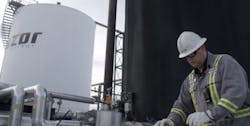Canadian Oil and Gas producer utilizing Drilling Ops to create Gas-Geothermal Power
Razor Energy and its wholly owned subsidiary FutEra Power have announced the completed construction, commissioning and operational start of a co-produced geothermal power project in Swan Hills in Alberta, Canada.
Razor is a publicly traded junior oil and gas development and production company headquartered in Calgary, Alberta.
The project, held within FutEra’s wholly-owned subsidiary Swan Hills Geothermal Power, combines an organic Rankine cycle turbine (ORC) and a natural gas turbine (NGT) with grid interconnections that enable direct sales of electricity to the Alberta electricity grid at merchant power prices.
The NGT began operations in September, while the ORC turbine, which captures geothermal heat from the production fluid, started up in January, Razor notes.
As part of its ongoing conventional oil and gas operations and waterflood activities, Razor produces and injects large volumes of hot production fluids on a daily basis, which serve as a renewable source of geothermal energy. FutEra leverages this opportunity to capture geothermal heat and generate power without producing any greenhouse gas emissions.
See our latest ENL Newsletter: Stories on Hydrogen, C&I Sustainability and Battery Recycling
Additionally, the co-production approach eliminates the need for new surface land footprint, as the project uses existing infrastructure, including producing wells, processing facilities, a produced water reinjection system, and an operating gathering and distribution system, Razor says.
The C$49 million (about $36M U.S., at current exchange rates) project was privately financed by Razor and institutional asset manager Arena Investors. The project received C$7.75 million from Natural Resource Canada’s Clean Growth Program and C$2 million from Alberta Innovates. It also received funding of C$10 million from Emissions Reduction Alberta (ERA), which was sourced from the government of Alberta’s Technology Innovation and Emissions Reduction fund.
“On behalf of the Government of Canada, I would like to congratulate Razor Energy and FutEra on the successful construction and commissioning of Canada’s first co-produced geothermal power project,” said Jonathan Wilkinson, Canada’s Minister of Natural Resources. “Supported by investments from Natural Resources Canada, this project demonstrates the power of innovation and partnership in creating sustainable jobs while growing the economy here in Alberta and across Canada.”
According to Razor, the next phase of the project will see the addition of solar and carbon capture with the aim of creating a net-negative carbon-emitting traditional oil and gas asset.
FutEra and Razor also plan to continue their geothermal energy development efforts by designing and constructing a second co-produced geothermal power project by 2024.
Razor's work in the Swan Hills development is actually a revival of dormant oil and gas play dating to the 1960s. The company is working in four legacy fields and has reactivated over 60 wells.
About the Author
EnergyTech Staff
Rod Walton is senior editor for EnergyTech.com. He has spent 17 years covering the energy industry as a newspaper and trade journalist.
Walton formerly was energy writer and business editor at the Tulsa World. Later, he spent six years covering the electricity power sector for Pennwell and Clarion Events. He joined Endeavor and EnergyTech in November 2021.
He can be reached at [email protected].
EnergyTech is focused on the mission critical and large-scale energy users and their sustainability and resiliency goals. These include the commercial and industrial sectors, as well as the military, universities, data centers and microgrids.
Many large-scale energy users such as Fortune 500 companies, and mission-critical users such as military bases, universities, healthcare facilities, public safety and data centers, shifting their energy priorities to reach net-zero carbon goals within the coming decades. These include plans for renewable energy power purchase agreements, but also on-site resiliency projects such as microgrids, combined heat and power, rooftop solar, energy storage, digitalization and building efficiency upgrades.
